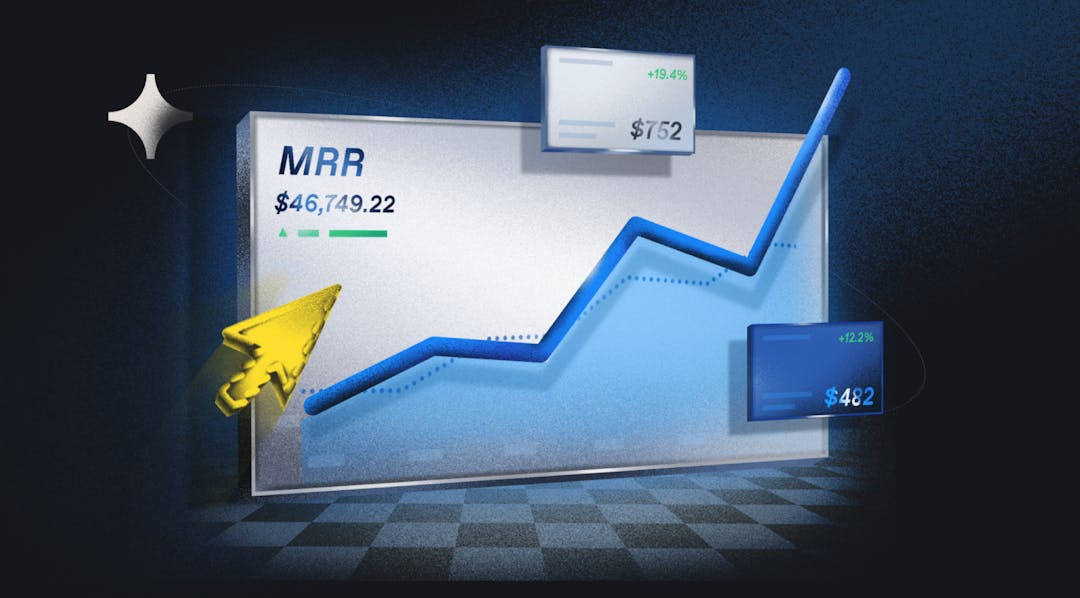For most companies, product and feature launches are always top of mind because of the potential to attract and retain more users.
Product launch strategies aim for user adoption and brand growth. They are linear and focus on sharing a new product or feature with the entire user base via email campaigns, regular notifications, posts on platforms like Product Hunt, and general press.
While this approach gets the product or feature in front of a large audience — and results in a short-term spike in growth — there's a lot of needless friction along the way. So much so that developing a sustainable growth strategy isn't likely to happen.
Brian Balfour, Founder and CEO of Reforge, spoke at Recur conference and explained why this approach doesn't work (and what you should do instead).
What is a product launch strategy?
A product launch strategy is a planned effort to launch a new product in a market. The goal of most businesses is to launch something and get as much growth and traction as quickly as possible. Many steps, actions, and people are involved in a project launch process. Because of this, having a launch strategy helps you stay focused on the end goal.
The standard product launch strategy is holding you back
Brian shared a quote from the founders of TBH, a social quiz app for teens that was acquired by Facebook, that briefly explains how they were able to launch their product.
“It's critical to design a process that allows you to launch vastly different product experiences within specific communities so your product can reach critical mass.”
Taking a one-size-fits-all approach can only hold it back. Instead, companies should make sure that the product launch is tailored to the product one is launching and to the intended audience, similarly to what TBH did.
4 common reasons product launches fail
Often, companies skirt around this concept and, as Brian points out, their new product launch strategy fails for one of four reasons. Let's discover how these hold you back from long-term growth.
1. Word-of-mouth is not enough
At the heart of almost every successful growth strategy is word of mouth (WOM). Brian explained that a good way to evaluate your growth is to take away all other forms of your marketing strategy — this means emails, paid ads, anything that promotes your product — and see whether your company continues to grow.
If churn outpaces growth, then WOM isn’t strong enough to support your business on its own. With WOM, growth might be slow over time, but this sets the stage for accelerated growth later on because it builds such a strong foundation.
The problem, as Brian pointed out, is that “brands see WOM as something that just happens, not scientific, and not something that can be controlled.”
Think of WOM as a loop that looks something like this:
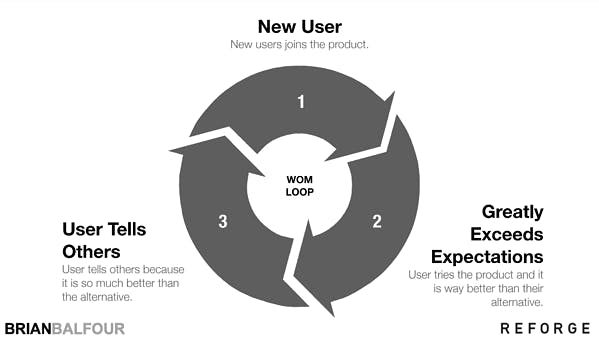
New users sign up to use a product, they use the product and realize that it exceeds their expectations in comparison to other alternatives, and in turn tell other people about it. Those people decide to try the product as well, and the loop repeats itself.
What brands don't realize is that Step 2 of the loop, Greatly Exceeds Expectations, can indeed be controlled. Brian explained that, at this point, you control “the audience coming in and what the audience experience is.”
All too often, product launch strategies show the same promotional material to the entire audience and expect users to want to share it. But because new products and features are launched as early versions not meant for everyone, users whose expectations have not yet been greatly exceeded give negative feedback and kill the WOM cycle.
The people you want to focus on are those you’ll meet at Step 2 — it’s the segment of users who are most likely to have already had their expectations met and will be most likely to tell everyone about a new product or feature.
2. Validating product and feature hypothesis slows down
An important part of your launch plan is validating the product and feature quickly. This is done by using the following:
Qualitative signals
Like Net Promoter Score (NPS) and Customer Satisfaction Score (CSAT) can be corrupted when you get negative feedback from users who are not meant to test the first version of your product or feature. Avoid “noisy” qualitative feedback, which hides the real feedback you need and slows down your validation process, by segmenting your audience.
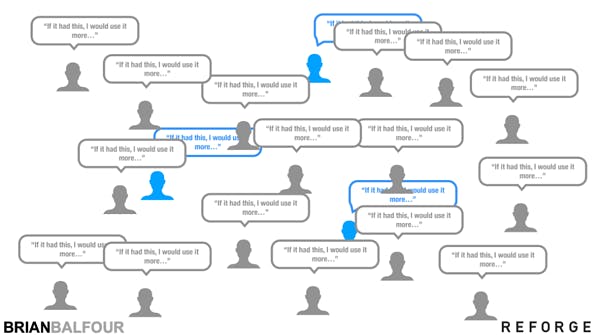
Feedback from the entire user base (in gray) drowns out the feedback from your target segment (in blue).
Quantitative signals
Like retention curves show how well you're able to retain users over time and deliver on the promised value. Without segmenting your audience, this, too, can result in a slow validation process.

Launching to everyone results in lower retention rates over time.
Brian explains “It's easy to think that we can work backwards to try to find that diamond in the rough. In reality and in practice, this is 10X more difficult than we actually think it is... It's highly unlikely that you'll find that diamond in the rough in hindsight if you fill your system with needless data.”
The result is that it takes much longer to deliver on a product that meets the needs of the right segment of your audience.
3. Too much communication
Users have only so much attention to give your product. It's in your best interest to be protective of their experiences and avoid bombarding them with irrelevant messages that test their patience.
Reforge uses the “Psych” Framework, developed by Darius Contractor, to determine user intention and motivation. “Psych,” Brian explained, is defined as “a unit of measurement of user motivation or attention.”
Brian used the analogy of a fuel tank that can be filled with all the items users want. He explained that these are things that add value, meet user needs, and result in a positive experience. But fuel can also be removed from the tank — for example, irrelevant messages consume fuel.
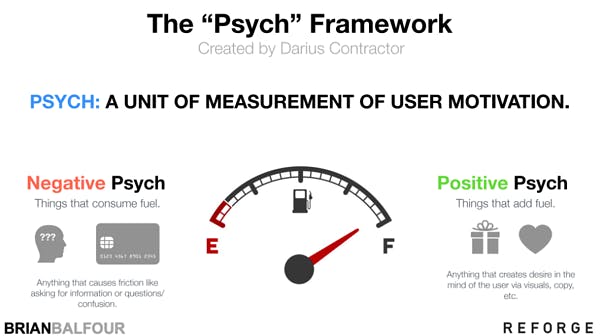
The problem, as Brian pointed out, is that “it's much harder to fill the fuel tank than it is to drain it in today's environment, where all of our customers are getting overwhelmed with messages.” The reasoning is that irrelevant messages require more of a user's attention than positive, targeted messages, which require less attention.
Standard, linear product launch strategies target all users, an approach that depletes the fuel tank and threatens successful future launches.
4. Only envisioning the short-term
The goal for launches is to create a long-term, sustainable growth strategy. Reforge thinks about their sustainable growth strategy as a qualitative growth model grounded in strong communication. This includes various components, like publishing and endorsements, categorized by acquisition loops that feed the system and by habit loops that manage retention.
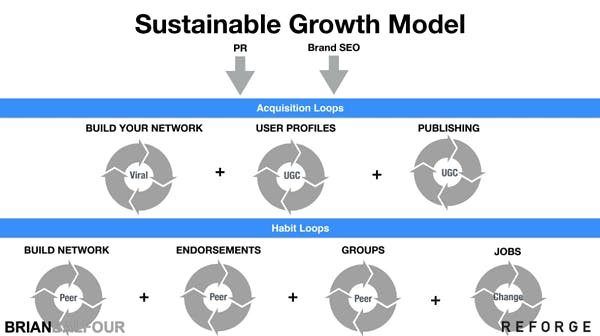
Are you setting yourself up for success? Brian suggested asking yourself two questions:
- How does one cohort of users lead to another cohort of users? This requires you to look at the series of actions that leads to getting more users in the future.
- How does one user interaction lead to more interactions? This requires you to look at how your system retains users.
The problem is that a lot of time and energy goes into thinking about launches and little time goes into making sure the strategy behind them leads to medium- and long-term growth.

Brian advised switching that thinking so that “the launch is used in service of the model. It's there to jump-start that engine and the sustainable system.” He continued, “The launch isn't meant to be the be-all and end-all because it only provides a short-term spike that goes away very quickly.”
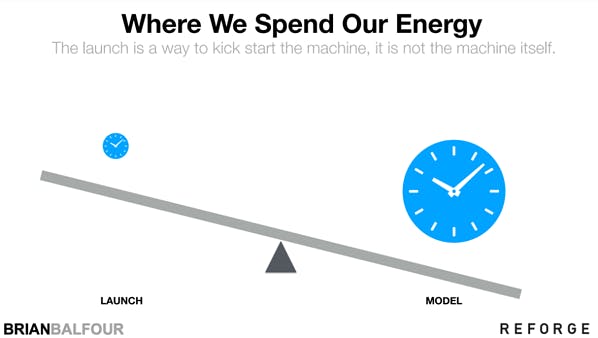
So how do you improve product launches? Stop launching to the masses and start small.
How to launch a product in 5 steps
Instead of the standard product launch strategy, use a more detailed, five-part loop based on TBH's approach to growth: Launch a vastly different product experience to specific communities in order to reach critical mass.
When these elements are combined, you’ll find the right users to target and improve long-term retention. Here's what the product launch process (or “loop”) looks like:
- Define your scope
- Access who needs the product
- Filter your list for the best users
- Use a success signal
- Leverage your signals for the next user group

We define these launch strategy steps in more detail below.
1. Scope the launch
Start by defining your target audience. Brian explained that instead of blasting your entire audience with your product or feature, you should use product development to build products and features for specific audiences.
This requires narrowing down your target audience within your user base as much as possible.
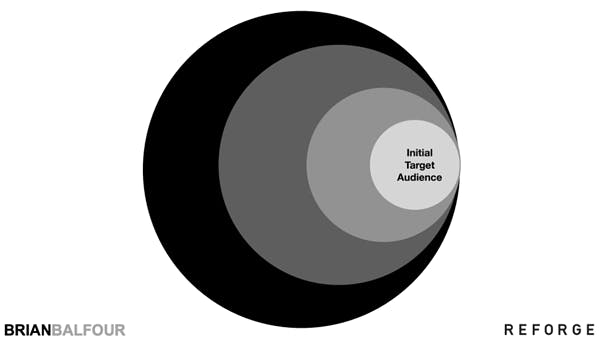
Once you've scoped out your audience, define it so that you're targeting the people most likely to have already had an experience with your products that exceeded their expectations.
2. Access your target audience
Next, get in front of these people. Use tactics like Hacker News, email, paid ads, press releases, a changelog to announce product changes, referrals, Medium blog posts, and Product Hunt to promote your product or feature to your audience.
3. Filter to your best users
Once you have your audience's attention, find the users most likely to appreciate and understand the beta version of your product or feature. Who are your early adopters?
Brian explained that sharing your launch with your target group is a little like casting a net. You're going to find some people who fit the scope you've defined, and others who aren't an exact fit. Filtering helps you get to the right audience.
To find your audience, gather information from the following sources:
Clearbit
This gives you access to “passive data,” so when users sign up, you can use their email addresses to learn more about your audience. For example, their company, its size, their role, and the location.
Internal data
This includes information you gather from sales and support conversations if you're launching a feature within an existing product.
User-submitted information
This offers good friction and helps you find your target audience. For example, use surveys, wait-lists, and special-access lists that incentivize the right people to join.
4. Identify a success signal
Brian pointed out that narrowing down your target audience makes it easier to get to success signals than if you target everyone at once.
The result is more accurate, less noisy qualitative and quantitative signals that give a stronger indication of whether you've achieved product/market fit.
If you're launching a feature inside a larger product, go one step further to find feature/product fit. Casey Winters, former growth lead at Pinterest and Grubhub, explains feature/product fit this way:
"Feature/product fit requires the feature to improve retention, engagement, and/or monetization for the core product... If it doesn't, this means it is cannibalizing another part of the product."
Without feature/product fit, you end up with lots of new features but no lift to retained users.

A better scenario is to introduce features that support the product and have a positive effect on the retention curve. Feature/product shifts the curve up to show that the adoption of new features results in higher customer engagement and retention.
5. Leverage for your next launch
The final step of the loop, once the success signals have been identified, is to figure out how to leverage these signals and launch to the next group of defined target users.
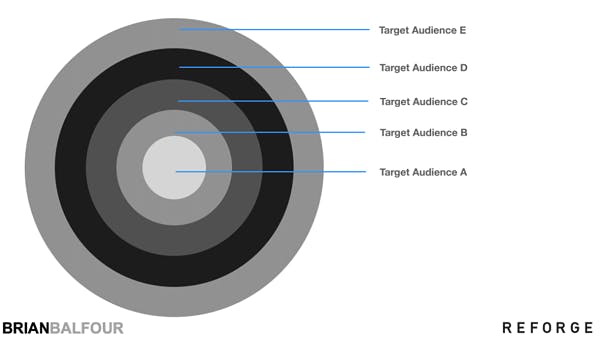
It takes time to release a product or feature, so the goal should be to introduce it to a new layer of users as you go until it's eventually exposed to your entire user base.
Brian encourages to “Expose your product or feature to more users progressively over time as more value is added to the product... For example, tightly control the WOM loop and validation until the point where you hit a tipping point and can launch to everyone without worrying about killing WOM loop and slowing down validation process with too much friction.”
Keep repeating this five-step loop until you get the new product or feature out to all users.
Companies prove this system works
An example of a company making this five-step approach work is Superhuman, a fast, new email service provider.
It was launched over two years ago but isn't publicly available yet. To get access, interested users have to join a waitlist first and then go through an extensive validation process to determine whether they're an ideal user.
Based on Brian's experience, his validation process looked like this:
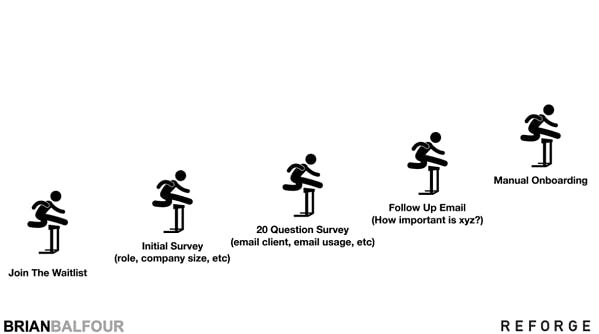
After joining the waitlist, there was an initial survey to gauge basic demographics. Then there was a more detailed 20-question survey about email usage. This was followed by a manual follow-up email meant to clarify one of the answers from the survey. The final step was a manual onboarding process that leads had to sign up for.
For most people, this process would be a turnoff. But the results show that this company has more WOM promotion than most new companies. They're using the five-step process, which allows them to identify their ideal target users with the waitlist, filter users down with survey questions, measure success signals by verifying product/market fit, and leveraging this through the tech press and social media shoutouts they receive.
The main takeaway here is to realize you can't launch to everyone and then narrow down your target list based on who uses the product most. You can't start big and then work backward based on what sticks.
While this approach might have worked for a product like Flickr, it's rare and doesn't work for the majority of brands. This approach fails because of one of the four reasons typical launches don't work. A better approach is to stick to a proven, structured, scientific process that has proven to get results.
Getting started
The five-step, repeatable launch process works and is a quicker path to validating questions and assumptions. There is more work required up front in your pre-launch phase, but this pays off in the end with a higher retention curve.
Take a look at your product launch strategy as it stands today, and find gaps and opportunities to filter your target user audience and find your success signals.
Developing your customized, repeatable launch process takes trial and error because tactics that work for one company may not necessarily work for you. You can nail your next product launch with the right market research and pre-launch planning. Find your mix of tactics, product tools, and processes that will get you to attract more of the right users and retain them for longer.
Product launch strategy FAQs
Here are the answers to the most popular product launch strategy questions.
How do you create a product launch strategy?
A product launch strategy has many steps and moving parts. It usually takes multiple teams and people to both create and implement it. Some of the most common steps include: Understanding the problem the product is trying to solve, deciding what channels to promote the product, creating launch assets, and doing a post-launch retrospective.
What are the six steps of a product launch plan?
The six steps of a product launch are: testing the product before the launch, training the team, preparing for the launch, launching the product, establishing launch metrics, and the post-launch retrospective.
What are the three types of product launches?
In software development, most product launches fall under one or more of the three types. They are:
- Products that create new value
- Maintenance or support of an existing product
- Investing in internal products and other capabilities



